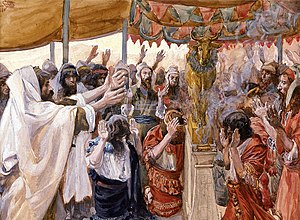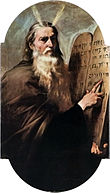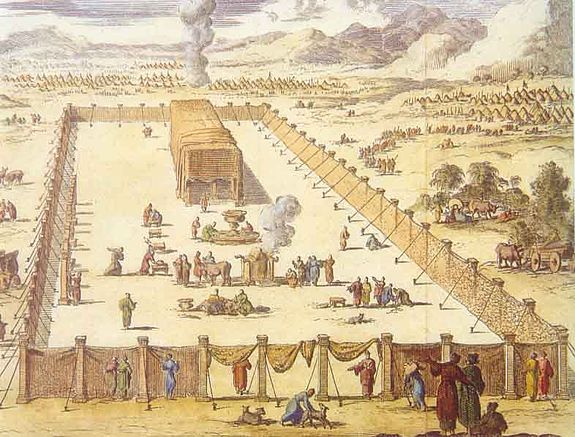
A | B | C | D | E | F | G | H | CH | I | J | K | L | M | N | O | P | Q | R | S | T | U | V | W | X | Y | Z | 0 | 1 | 2 | 3 | 4 | 5 | 6 | 7 | 8 | 9

Ki Tisa, Ki Tissa, Ki Thissa, or Ki Sisa (כִּי תִשָּׂא—Hebrew for "when you take," the sixth and seventh words, and first distinctive words in the parashah) is the 21st weekly Torah portion (parashah) in the annual Jewish cycle of Torah reading and the ninth in the Book of Exodus. The parashah tells of building the Tabernacle, the incident of the Golden calf, the request of Moses for God to reveal God's Attributes, and how Moses became radiant.
The parashah constitutes Exodus 30:11–34:35. The parashah is the longest of the weekly Torah portions in the book of Exodus (although not the longest in the Torah, which is Naso), and is made up of 7,424 Hebrew letters, 2,002 Hebrew words, 139 verses, and 245 lines in a Torah scroll (Sefer Torah).[1]
Jews read it on the 21st Sabbath after Simchat Torah, in the Hebrew month of Adar, corresponding to February or March in the secular calendar.[2] Jews also read the first part of the parashah, Exodus 30:11–16, regarding the half-shekel head tax, as the maftir Torah reading on the special Sabbath Shabbat Shekalim (as on March 1, 2014, when Exodus 30:11–16 was read along with parashah Pekudei). Jews also read parts of the parashah addressing the intercession of Moses and God's mercy, Exodus 32:11–14 and 34:1–10, as the Torah readings on the fast days of the Tenth of Tevet, the Fast of Esther, the Seventeenth of Tammuz, and the Fast of Gedaliah, and for the afternoon (Mincha) prayer service on Tisha B'Av. Jews read another part of the parashah, Exodus 34:1–26, which addresses the Three Pilgrim Festivals (Shalosh Regalim), as the initial Torah reading on the third intermediate day (Chol HaMoed) of Passover. And Jews read a larger selection from the same part of the parashah, Exodus 33:12–34:26, as the initial Torah reading on a Sabbath that falls on one of the intermediate days of Passover or Sukkot.
Readings
In traditional Sabbath Torah reading, the parashah is divided into seven readings (עליות, aliyot). In the Masoretic Text of the Tanakh (Hebrew Bible), Parashat Ki Tisa has ten "open portion" (פתוחה, petuchah) divisions (roughly equivalent to paragraphs, often abbreviated with the Hebrew letter פ (peh)). Parashat Ki Tisa has several further subdivisions, called "closed portion" (סתומה, setumah) divisions (abbreviated with the Hebrew letter ס (samekh)) within the open portion divisions. The first three open portion divisions divide the long first reading (aliyah), and the next three open portion divisions divide the long second reading.[3] The seventh open portion corresponds to the short third reading, and the eighth open portion corresponds to the short fourth reading. The ninth open portion spans the fifth and sixth readings. And the tenth open portion begins in the seventh reading. Closed portion divisions further divide the first and second readings, and conclude the seventh reading.[4]

First reading—Exodus 30:11–31:17
In the long first reading, God instructed Moses that when he took a census of the Israelites, each person 20 years old or older, regardless of wealth, should give a half-shekel offering.[5] God told Moses to assign the proceeds to the service of the Tent of Meeting.[6] The first open portion ends here.[7]
In the continuation of the reading, God told Moses to place a copper laver (כִּיּוֹר, kiyor) between the Tent of Meeting and the altar (מִּזְבֵּחַ, mizbeiach), so that Aaron and the priests could wash their hands and feet in water when they entered the Tent of Meeting or approached the altar to burn a sacrifice, so that they would not die.[8] The second open portion ends here.[9]
In the continuation of the reading, God directed Moses to make a sacred anointing oil from choice spices—myrrh, cinnamon, cassia—and olive oil.[10] God told Moses to use it to anoint the Tent of Meeting, the furnishings of the Tabernacle, and the priests.[11] God told Moses to warn the Israelites not to copy the sacred anointing oil's recipe for lay purposes, at pain of exile.[12] A closed portion ends here.[13]

In the continuation of the reading, God directed Moses make sacred incense from herbs—stacte, onycha, galbanum, and frankincense—to burn in the Tent of Meeting.[14] As with the anointing oil, God warned against making incense from the same recipe for lay purposes.[15] Another closed portion ends here with the end of chapter 30.[16]
As the reading continues in chapter 31, God informed Moses that God had endowed Bezalel of the Tribe of Judah with divine skill in every kind of craft.[17] God assigned to him Oholiab of the Tribe of Dan and granted skill to all who are skillful, that they might make the furnishings of the Tabernacle, the priests' vestments, the anointing oil, and the incense.[18] The third open portion ends here.[19]
In the continuation of the reading, God told Moses to admonish the Israelites nevertheless to keep the Sabbath, on pain of death.[20] The first reading and a closed portion end here.[21]

Second reading—Exodus 31:18–33:11
In the long second reading, God gave Moses two stone tablets inscribed by the finger of God.[22] Meanwhile, the people became impatient for the return of Moses, and implored Aaron to make them a god.[23] Aaron told them to bring him their gold earrings, and he cast them in a mold and made a molten golden calf.[24] They exclaimed, "This is your god, O Israel, who brought you out of the land of Egypt!"[25] Aaron built an altar before the calf, and announced a festival of the Lord.[26] The people offered sacrifices, ate, drank, and danced.[27] The fourth open portion ends here.[28]
In the continuation of the reading, God told Moses what the people had done, saying "let Me be, that My anger may blaze forth against them and that I may destroy them, and make of you a great nation."[29] But Moses implored God not to do so, lest the Egyptians say that God delivered the people only to kill them off in the mountains.[30] Moses called on God to remember Abraham, Isaac, and Jacob, and God's oath to make their offspring as numerous as the stars, and God renounced the planned punishment.[31] The fifth open portion ends here.[32]

In the continuation of the reading, Moses descended the mountain bearing the two tablets.[33] Joshua told Moses, "There is a cry of war in the camp," but Moses answered, "It is the sound of song that I hear!"[34] When Moses saw the calf and the dancing, he became enraged and shattered the tablets at the foot of the mountain.[35] He burned the calf, ground it to powder, strewed it upon the water, and made the Israelites drink it.[36] When Moses asked Aaron how he committed such a great sin, Aaron replied that the people asked him to make a god, so he hurled their gold into the fire, "and out came this calf!"[37] Seeing that Aaron had let the people get out of control, Moses stood in the camp gate and called, "Whoever is for the Lord, come here!"[38] All the Levites rallied to Moses, and at his instruction killed 3,000 people, including brother, neighbor, and kin.[39] Moses went back to God and asked for God either to forgive the Israelites or kill Moses too, but God insisted on punishing only the sinners, which God did by means of a plague.[40] A closed portion ends here with the end of chapter 32.[41]
As the reading continues in chapter 33, God dispatched Moses and the people to the Promised Land, but God decided not to go in their midst, for fear of destroying them on the way.[42] Upon hearing this, the Israelites went into mourning.[43] Now Moses would pitch the Tent of Meeting outside the camp, and Moses would enter to speak to God, face to face.[44] The second reading and the sixth open portion end here.[45]
Third reading—Exodus 33:12–16
In the short third reading, Moses asked God whom God would send with Moses to lead the people.[46] Moses further asked God to let him know God's ways, that Moses might know God and continue in God's favor.[47] And God agreed to lead the Israelites.[48] Moses asked God not to make the Israelites move unless God were to go in the lead.[49] The third reading and the seventh open portion end here.[50]
Fourth reading—Exodus 33:17–23
In the short fourth reading, God agreed to lead them.[51] Moses asked God to let him behold God's Presence.[52] God agreed to make all God's goodness pass before Moses and to proclaim God's name and nature, but God explained that no human could see God's face and live.[53] God instructed Moses to station himself on a rock, where God would cover him with God's hand until God had passed, at which point Moses could see God's back.[54] The fourth reading and the eighth open portion end here with the end of chapter 33.[55]
Fifth reading—Exodus 34:1–9
In the fifth reading, in chapter 34, God directed Moses to carve two stone tablets like the ones that Moses shattered, so that God might inscribe upon them the words that were on the first tablets, and Moses did so.[56] God came down in a cloud and proclaimed: "The Lord! The Lord! A God compassionate and gracious, slow to anger, abounding in kindness and faithfulness, extending kindness to the thousandth generation, forgiving iniquity, transgression, and sin; yet He does not remit all punishment, but visits the iniquity of parents upon children and children's children, upon the third and fourth generations."[57] Moses bowed low and asked God to accompany the people in their midst, to pardon the people's iniquity, and to take them for God's own.[58] The fifth reading ends here.[59]

Sixth reading—Exodus 34:10–26
In the sixth reading, God replied by making a covenant to work unprecedented wonders and to drive out the peoples of the Promised Land.[60] God warned Moses against making a covenant with them, lest they become a snare and induce the Israelites' children to lust after their gods.[61] God commanded that the Israelites not make molten gods, that they consecrate or redeem every first-born, that they observe the Sabbath, that they observe the Three Pilgrim Festivals, that they not offer sacrifices with anything leavened, that they not leave the Passover lamb lying until morning, that they bring choice first fruits to the house of the Lord, and that they not boil a kid in its mother's milk.[62] The sixth reading and the ninth open portion end here.[63]

Seventh reading—Exodus 34:27–35

In the seventh reading, Moses stayed with God 40 days and 40 nights, ate no bread, drank no water, and wrote down on the tablets the terms of the covenant.[64] As Moses came down from the mountain bearing the two tablets, the skin of his face was radiant, and the Israelites shrank from him.[65] Moses called them near and instructed them concerning all that God had commanded.[66]
In the maftir (מפטיר) reading of Exodus 34:33–35 that concludes the parashah,[67] when Moses finished speaking, he put a veil over his face.[68] Whenever Moses spoke with God, Moses would take his veil off.[69] And when he came out, he would tell the Israelites what he had been commanded, and then Moses would then put the veil back over his face again.[70] The parashah and the final closed portion end here with the end of chapter 34.[71]
Readings according to the triennial cycle
Jews who read the Torah according to the triennial cycle of Torah reading read the parashah according to the following schedule:[72]
| Year 1 | Year 2 | Year 3 | |
|---|---|---|---|
| 2023, 2026, 2029 . . . | 2024, 2027, 2030 . . . | 2025, 2028, 2031 . . . | |
| Reading | 30:11–31:17 | 31:18–33:11 | 33:12–34:35 |
| 1 | 30:11–13 | 31:18–32:6 | 33:12–16 |
| 2 | 30:14–16 | 32:7–11 | 33:17–23 |
| 3 | 30:17–21 | 32:12–14 | 34:1–9 |
| 4 | 30:22–33 | 32:15–24 | 34:10–17 |
| 5 | 30:34–38 | 32:25–29 | 34:18–21 |
| 6 | 31:1–11 | 32:30–33:6 | 34:22–26 |
| 7 | 31:12–17 | 33:7–11 | 34:27–35 |
| Maftir | 31:15–17 | 33:9–11 | 34:33–35 |

In ancient parallels
The parashah has parallels in these ancient sources:
Exodus chapter 31
Noting that Sargon of Akkad was the first to use a seven-day week, Gregory Aldrete speculated that the Israelites may have adopted the idea from the Akkadian Empire.[73]
Exodus chapter 33
Exodus 3:8 and 17, 13:5, and 33:3, Leviticus 20:24, Numbers 13:27 and 14:8, and Deuteronomy 6:3, 11:9, 26:9 and 15, 27:3, and 31:20 describe the Land of Israel as a land flowing "with milk and honey." Similarly, the Middle Egyptian (early second millennium BCE) tale of Sinuhe Palestine described the Land of Israel or, as the Egyptian tale called it, the land of Yaa: "It was a good land called Yaa. Figs were in it and grapes. It had more wine than water. Abundant was its honey, plentiful its oil. All kind of fruit were on its trees. Barley was there and emmer, and no end of cattle of all kinds."[74]
In inner-Biblical interpretation
The parashah has parallels or is discussed in these Biblical sources:[75]
Exodus chapters 25–39
This is the pattern of instruction and construction of the Tabernacle and its furnishings:

| Item | Instruction | Construction | ||
|---|---|---|---|---|
| Order | Verses | Order | Verses | |
| Contributions | 1 | Exodus 25:1–9 | 2 | Exodus 35:4–29 |
| Ark | 2 | Exodus 25:10–22 | 5 | Exodus 37:1–9 |
| Table | 3 | Exodus 25:23–30 | 6 | Exodus 37:10–16 |
| Menorah | 4 | Exodus 25:31–40 | 7 | Exodus 37:17–24 |
| Tabernacle | 5 | Exodus 26:1–37 | 4 | Exodus 36:8–38 |
| Altar of Sacrifice | 6 | Exodus 27:1–8 | 11 | Exodus 38:1–7 |
| Tabernacle Court | 7 | Exodus 27:9–19 | 13 | Exodus 38:9–20 |
| Lamp | 8 | Exodus 27:20–21 | 16 | Numbers 8:1–4 |
| Priestly Garments | 9 | Exodus 28:1–43 | 14 | Exodus 39:1–31 |
| Ordination Ritual | 10 | Exodus 29:1–46 | 15
Zdroj:https://en.wikipedia.org?pojem=Ki_Tissa Text je dostupný za podmienok Creative Commons Attribution/Share-Alike License 3.0 Unported; prípadne za ďalších podmienok. Podrobnejšie informácie nájdete na stránke Podmienky použitia.
Analytika
Antropológia Aplikované vedy Bibliometria Dejiny vedy Encyklopédie Filozofia vedy Forenzné vedy Humanitné vedy Knižničná veda Kryogenika Kryptológia Kulturológia Literárna veda Medzidisciplinárne oblasti Metódy kvantitatívnej analýzy Metavedy Metodika Text je dostupný za podmienok Creative
Commons Attribution/Share-Alike License 3.0 Unported; prípadne za ďalších
podmienok. www.astronomia.sk | www.biologia.sk | www.botanika.sk | www.dejiny.sk | www.economy.sk | www.elektrotechnika.sk | www.estetika.sk | www.farmakologia.sk | www.filozofia.sk | Fyzika | www.futurologia.sk | www.genetika.sk | www.chemia.sk | www.lingvistika.sk | www.politologia.sk | www.psychologia.sk | www.sexuologia.sk | www.sociologia.sk | www.veda.sk I www.zoologia.sk | |
